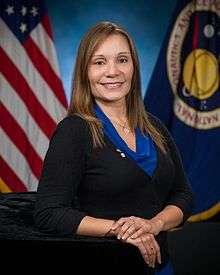Evelyn Miralles
| Evelyn Miralles | |
|---|---|
 | |
| Born |
1967[1] Venezuela |
| Alma mater |
Lamar University, University of Houston–Clear Lake |
Evelyn Miralles is a pioneer of virtual reality at NASA. Since 1993, her Dynamic Onboard Ubiquitous Graphics has been used to simulate space operations.
Career
Miralles wanted to be an architect "to build something" but, at the University of Houston, she started designing with computers. In 1990, she graduated from the Lamar University and, in 1992, from University of Houston–Clear Lake. She has worked since then at the Johnson Space Center's Virtual Reality Laboratory[2] for over 20 years in Houston (Texas,[1] where she is the Principal Engineer and Technology Strategist. Her work is used to train astronauts in extravehicular activity.
Since 1992, Miralles has been supporting space shuttle and International Space Station missions. Her first project was building a 3D model of a habitat on the moon. It was not feasible but could possibly be used in the future for a mission to Mars.[1] Miralles was the co-author of the Dynamic Onboard Ubiquitous Graphics (DOUG) which has been used since 1993 for training in virtual reality by astronauts of STS 61 mission who repaired the space telescope Hubble, and then for all the other missions.[1] She worked also in the space station ISS, designing the structure and work steps for the astronauts.
Miralles is involved with science outreach. She will keynote Hispanicize 2017.[3]
Awards
- One of BBC 100 Inspirational Women in the World BBC 100 Women - 2016[4]
- University of Houston–Clear Lake - Distinguish Alumna Award - 2016[3]
- CNET in Spanish Top 20 most influential Hispanics in the US - 2016[3]
- NASA Space Flight Safety Award "Silver Snoopy Award" - 2012[3]
References
- 1 2 3 4 "Biografía de Evelyn Miralles, innovadora principal de ingeniería del Virtual Reality Laboratory, NASA Johnson Space Center. Latinos en tecnología 2016". CNET en Español (in Spanish). 22 September 2016. Retrieved 8 December 2016.
- ↑ "Young women need strong female role models—and Evelyn Miralles is one". JSC Features. NASA. 23 March 2015. Retrieved 8 December 2016.
- 1 2 3 4 "World Renowned NASA Virtual Reality Pioneer Evelyn Miralles to Keynote Hispanicize CMO Summit". GlobeNewswire. 1 December 2016.
- ↑ "BBC 100 Women 2016: Who is on the list?". BBC. 21 November 2016.
External links
| Wikimedia Commons has media related to Evelyn Miralles. |